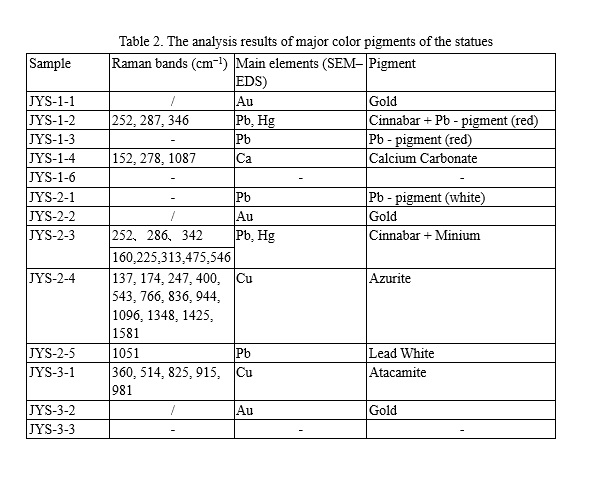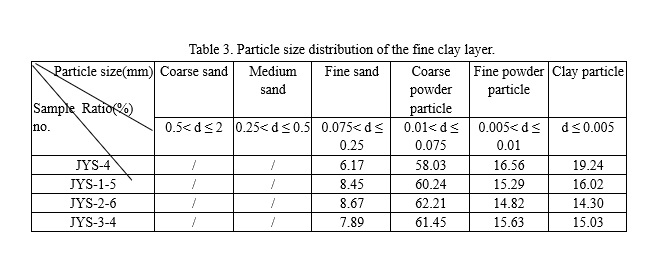In-situ observation
The in-situ microphotographs as shown in Fig.3, reveal multiple paint layers of the sculptures. The results indicated that the general sequences and combinations of layers are different for the three sculptures. As seen from Fig.3a, at least four paint layers were found for the sculpture of Tutang Buddha from top to the bottom, which were: black (L1) – paper - red (L2) –paper - green (L3) – paper - dark green (L4). At the bottom of the kasaya (Fig.3 (b)), the sequence of the paint layers was gold (L1) – paper - red (L2) – paper - red (L3) – white (L4). In addition, the examination (Fig.3 (c)) of the sculpture of Mahasthamaprapta bodhisattva demonstrated that the white pigment layer was overlapped by the green pigment layer.
Repainting seriously damaged sculptures was common in ancient China. The ancient Chinese craftsmen usually applied mud and lime to cover the original paint layer and repainted it. Later, mainly in the Ming and Qing dynasties, the processes changed slightly by covering the paint layer with several layers of paper repainted [16]. According to the in-situ observation, at least two layers of paper were found at the three sculptures with three or four layers of paper in some parts. Meanwhile, the inscriptions proved that the sculptures were restored repeatedly in A.D. 1541 (the reign of the Jiajing Emperor in the Ming Dynasty) and A.D. 1739 (the reign of the Qianlong Emperor in the Qing Dynasty). Multi-layers paintings were also investigated in the paintings [17] and wooden statues [18]. The result not only help us to deepen the knowledge of the historical and cultural value but also help the restorers to determine whether the overlapping layers need to be removed.
Analysis of the pigments
The major colours of the sculptures are gold, red, blue, green, white, black, etc. Table 2 shows an overview of the pigments that were identified by SEM-EDS and Micro-Raman spectroscopy (Fig 4-1, 4-2, 5-1, 5-2). As shown in Table 1, samples were covered by pollutant minerals (mainly from dust), which caused the detection of elements such as Si, Al, K, Fe in samples [14].
Gilding technique, which uses original materials of gold, silver, copper or tin to the object surface [16, 19-21], has been an ancient technique widely applied in both China and Europe. It has been commonly used in sculptures painting since Song dynasty (A.D. 960 - A.D. 1279) [20]. For example, gilding decoration has been applied on the exposed skin and cassock to present the Buddha’s magnificence, splendor and solemnity. This technique was also used in decorating the sculptures of Jingyin Temple, as SEM-EDS results (Fig.4-1 (a), 4-1 (f), 4-2 (k)) of samples JYS-1-1, JYS-2-2, JYS-3-2 suggested a high level of gold (Au) and further revealed that gold leaf was attached to the surface of the sculptures to form a gorgeous appearance.
SEM-EDS and Micro-Raman were performed on three red pigments. The elements (Fig.4-2 (g)) of Hg, S and Pb were found by SEM-EDS in sample JYS-2-3. Different results of the Micro-Raman spectroscopy were obtained at two detection points of red Sample JYS-2-3. At one point, the strong Raman peaks (Fig.5-1 (c)) at 252, 286, 342 cm-1, which corresponded well to characteristic Raman bands of cinnabar (HgS) [22-24]. Moreover, the strong Raman peaks (Fig.5-1 (d)) at 160, 225, 313, 475, 546 cm-1 were assigned to minium (Pb3O4). The strong absorption at 546cm-1 was attributed to the stretching of the Pb-O bond [14, 25, 26]. The result agreed with SEM-EDS analysis and showed the red pigment was a mixture of cinnabar and minium. Using a mixed materials by two or more pigment in one color layer is a quite common traditional technique in ancient China [27, 28]. Amount of Hg in sample JYS-1-2 suggests the pigment of cinnabar which has been proved by Micro-Raman. On the other hand, the content of Pb (Fig.4-1 (b)) in sample JYS-1-2 may suggest a possibility of the pigment minium. Although the peaks of minium were not detected by Micro-Raman, many investigations [14, 21] of Pb-containing red pigment showed minium was popular used in ancient China. SEM-EDS (Fig.4-1 (c)) showed the same result in JYS-1-3.
The blue pigment (JYS-2-4), which was used in decorating the parts of kasaya of the sculpture of Avalokitesvara bodhisattva, was identified as azurite (2CuCO3·Cu(OH)2). All peaks (Fig.5-2 (e)) between 100 and 1,600 cm-1 (137, 174, 247, 400, 543, 766, 836, 944, 1096, 1348, 1425 and 1581 cm−1) were diagnostic Raman peaks assigned to azurite [29]. The main element (Fig.4-2 (h)) of the sample was Cu detected by SEM-EDS. It is well known that azurite was an most important blue mineral pigment both in ancient China [30] and in the European Middle Ages paintings [31]. The skirt and streamer of the sculpture of Mahasthamaprapta bodhisattva were painted with green pigment and gold which formed the brilliant colors and exquisite patterns. The green pigment (JYS-3-1) was identified as atacamite (Cu2Cl(OH)3). SEM-EDS analysis (Fig.4-2 (j)) reported relatively high level of Cu. Micro-Raman study (Fig.5-2 (g)) of the sample showed peaks at 360, 514, 825, 915, 981 cm-1, which were assigned to atacamite [32, 33].
Moreover, three white pigments were identified. Sample JYS-1-4 was calcium carbonate (CaCO3) [34], identified by its characteristic Raman band at (Fig.5-1 (b)) at 152, 278, 1087 cm-1 and large amount of Ca (Fig.4-1 (d)). Calcium carbonate has been used to paint white for quite a long time and was reported to be used in the art and archaeological objects, such as the mural painting [35, 36], architecture, et al. More interestingly, the main chemical constituent (Fig.4-2 (i)) of the white pigments of JYS-2-5 is Pb. The Raman band (Fig.5-2 (f)) registered at 1,051 cm-1 is attributed to lead white (2PbCO3 ·Pb(OH) 2) [12]. Lead white, based on basic lead carbonate, is known since ancient times due to its high covering power, and was the most commonly used white pigment until the nineteenth century [29]. Although Micro-Raman spectroscopy does not provide the peaks of lead white, given the white color and large amount of Pb (Fig. 4-1 (e)), it would be reasonable to assume that the white pigment of sample JYS-2-1 as lead white, as many investigations[33, 37] have indicated that lead white is popular used in Chinese history. The result overall indicated that the sculpture of Avalokitesvara bodhisattva was decorated by the white pigment of lead white.
Although Raman spectrometer is a helpful technique in the identification of the pigments, it should be mentioned that there are still limitations, such as certain pigments cannot be identified due to the strong fluorescence arising from the binding agent[38], the color and the compositions of the pigments were damaged due to the ageing, smoke damage and pollution[39], etc. For black pigment [40,41], the Roman band position and intensity depend on the carbon type, on the amount of disorder, on the orientation of the crystal with respect to the laser and on the measurement conditions.
Unfortunately, mainly due to the poor conservation or other reasons, Micro-Raman spectroscopy analysis failed to identify black pigments. A mass of literatures[40,42] show that carbon-based pigments, of mineral, vegetable or animal origin, composed ideally of pure carbon, have been identified in archaeological artifacts[43,44], rock art[45,46], easel and wall paintings[47], and sculptures[41]. Especially, the black pigments were determined to carbon-based black pigment in the painting [30, 48, 49] and sculptures [7,50] which is the same period with the Jingyin Temple. Based on the previous studies, it is interesting to speculate that carbon-based black pigment may also be used in the sculptures at Jingyin Temple. While the case could not be eliminated that the black pigments may be the organic compound due to the accumulation of long time smudging by folk burning incense in the devotional practice or the soot deposition resulting from burning bonfires[28]. Hopefully, further analytical methods could be used to provide more reliable evidence for the black pigment in the future.

Fiber identification of paper
Herzberg stain is usually used to distinguish fiber sources, because different fibers sources are dyed in different colors by the iodide/iodine mixed with zinc chloride solution [12]. After dyeing, the three paper fibers were shown as reddish brown in Fig.6 (a), (b), (c). The thickness of the fibers are different, in the range of 12 – 60 µm. There are numerous longitudinal stripes and transversal striations on the fiber walls. By comparing stained fibers with those most commonly used in Oriental papermaking, such as bast fibers (hemp, flex, ramie, paper mulberry, etc.), bamboos, and grass fibers (wheat and rice straws), it is indicated that the fiber sources of the three samples are ramie [51]. It is well known that ramie has its origin in China. Documental evidences show Tsai-lun invented a new process of paper-making, and remie has been used as one of the materials in Eastern Han dynasty [15] till now.
Phase identification of Clay minerals
Only samples of fine clay layer were taken for test due to the technical limitation. XRD patterns shown in Fig.7 suggested that quartz (SiO2) [52] and calcite (CaCO3) [53] were the primary crystalline phases in the fine clay layers and the soil from the hillside close to Jingyin Temple. The presence of minor albite (Na(AlSi3O8)) and gypsum (Ca(SO4)(H2O)2) in both JYS-2-6 and JYS-3-5 indicated they were applied simultaneously. XRD analyses revealed albite (Na(AlSi3O8)) was the minor component of JYS-1-5. The granulometric results of JYS-4, JYS-1-5, JYS-2-6, JYS-3-4 showed the particle sizes were mainly in the range of 0.0002 – 0.20 mm. The component particles of the samples were predominantly between 0.075 mm and 0.01 mm, with the content of coarse powder particle over 50%. It is also found that the particle size distributions, clay mineral compositions of fine clay layer and the color of the three sculptures were similar with those collected from the Juewei Mountain. Relevant studies suggested that the craftsmen made clay sculptures by collecting the raw materials from local area [54, 55]. Based on the previous research and the analytical results, the sources of the material remain uncertain, but the result is important for working out the restoration scheme and filtering the restoration materials.



